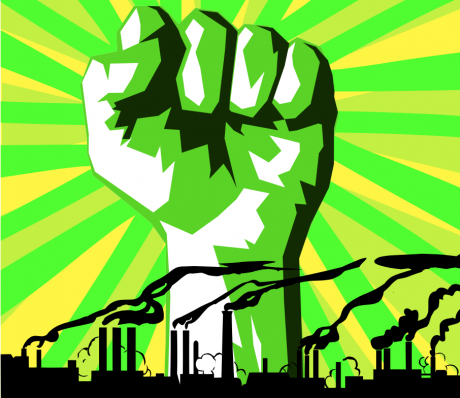Features
You are here
Raise wages not emissions

December 3, 2017
As Naomi Klein explained in This Changes Everything, “There’s a close correlation between low wages and high emissions…Exploited workers and an exploited planet are, it turns out, a package deal.”
It’s a decade since the economic crisis began, which led to massive job losses, cuts to services and stagnant wages. For workers across Canada the only solution seems to have been jobs in the tar sands, which can pay well at the cost of driving the climate crisis. But many of these jobs evaporated with the drop in the price of oil. Clearly alternatives are required for workers and the planet.
High carbon and low carbon jobs
The main argument against the climate justice movement is that it’s a job killer, as though tar sands companies cared about workers. But the dichotomy of jobs vs. the environment is based on two flawed assumptions. First, that workers in carbon-intensive industries have to either keep working in jobs that warm the planet, or lose their jobs. Second, that workers in carbon-intensive industries are the only workers relevant to climate politics.
But the correlation between wages and emissions are two-fold. On the one hand many high emission jobs like those in the tar sands pay workers what they deserve, while sacrificing the planet. On the other hand many low emission jobs are also low wage, preserving the climate while sacrificing workers’ standard of living.
So two sets of alternatives are required: a just transition for workers in high-carbon industries so they can transition to low-carbon work without sacrificing their wages, and increasing the wages of existing low-carbon jobs. As Naomi Klein explained at Unifor’s founding convention in 2013
“It’s not just boilermakers, pipefitters, construction workers and assembly line workers who get new jobs and purpose in this great transition. There are big parts of our economy that are already low-carbon. They’re the parts facing the most disrespect, demeaning attacks and cuts. They happen to be jobs dominated by women, new Canadians, and people of colour. And they’re also the sectors we need to expand massively: the care-givers, educators, sanitation workers, and other service sector workers. The very ones that your new union has pledged to organize. The low-carbon workers who are already here, demanding living wages and respect. Turning low-paying low-carbon jobs into higher-paying jobs is itself a climate solution and should be recognized as such. Here I think we should take inspiration from the fast-food workers in the United States and their historic strikes this past week. They are showing how this organizing can be done. Maybe it will turn out to be the first uprising in a sustained rebellion fighting for both real wages and real food! One in which the health of the workers and the health of society are inextricably linked.”
Linking workers and the climate
Since that time the climate and economic justice movements have grown and intersected. On the one hand there are national campaigns like Million Climate Jobs that show how creating climate jobs can lower emissions at the same time, as well as local campaigns like Reclaiming Alberta’s Future Today, a mass cleanup project to decommission and reclaim Alberta’s aging oil infrastructure. On the other hand, the strikes that Naomi Klein referenced have mushroomed into a massive fight for a $15 minimum wage across the US and Canada—raising the wages of millions of existing low-carbon jobs. As an organizer of a 2015 climate day of action in Vancouver explained, “We’re requesting an increased minimum wage so that there is an incentive to move out of polluting industries and so we have a viable choice to move into jobs that are greener. We are not able to say shut down oil without also having opportunities for people to move into jobs that they can make money on.”
Linking workers and the climate helps to bring class politics into the climate movement and climate politics into the labour movement. As the Leap Manifesto emphasizes, this applies to all workers across the carbon spectrum: “We want training and other resources for workers in carbon-intensive jobs, ensuring they are fully able to take part in the clean energy economy…Shifting to an economy in balance with the earth’s limits also means expanding the sectors of our economy that are already low carbon: caregiving, teaching, social work, the arts and public-interest media.”
In the past year a number of strikes have raised the wages of low-carbon workers, disproportionately women and racialized people. In the summer of 2016 Mississauga library workers, disproportionately women, won their strike raising the starting wage to $15/hr. Earlier this year York University food service workers, a majority of whom are racialized people, went on strike against poverty wages and racist employer and won $15/hr. Recently Toronto food terminal workers, all Tibetan refugees, went on strike and won paid sick days and other benefits. Striking Ontario college faculty also exposed the high precarity of low carbon education jobs, where 70 per cent of faculty are on short-term contract, and 60 percent of contract faculty are women.
This rising mood to strike for $15 and fairness is in the context of a movement that won an increase in the minimum wage and other gains for low-wage workers across Ontario, many of whom work in low carbon jobs. Because exploitation and oppression combine to concentrate women, Indigenous and racialized people in low-wage jobs, raising the minimum wage will disproportionately benefit these workers. As an economist with CCPA explained, “27% of Indigenous workers in Ontario will see a raise when the minimum wage hits $15 an hour. This is heavily weighted to First Nations workers, 30% of whom will see a bump to their income… The effect is similar to the strong impact a $15 minimum wage will have on the incomes of immigrant women, 42% of whom will get a raise.”
Here again we see the link between wages and emissions: those most impacted by the climate crisis—Indigenous communities whose territories are poisoned by tar sands, and migrant communities displaced by climate disasters—have the most to gain from raising the wages of low-carbon economy.
Looking ahead
The past few months of 2017 have seen two important victories for climate justice and economic justice: the canceling of Energy East pipeline and victories for $15 and fairness. But these are not guaranteed.
South of the border Trump is trying to revive Keystone XL and Dakota Access pipelines, while a right-wing backlash is trying to roll back the $15 minimum wage in different states. In Ontario Patrick Brown is running his election on a plan that includes delaying the $15/hr minimum wage and canceling the Climate Change Action Plan—proving again that low wages and high emissions are intertwined. But 2018 can also be the year of defending, extending and intertwining economic and ecologic justice: shutting down pipelines and divesting from fossil fuels, while investing in a just transition for workers in high carbon jobs and raising the wages of workers in low-carbon jobs.
Section:










